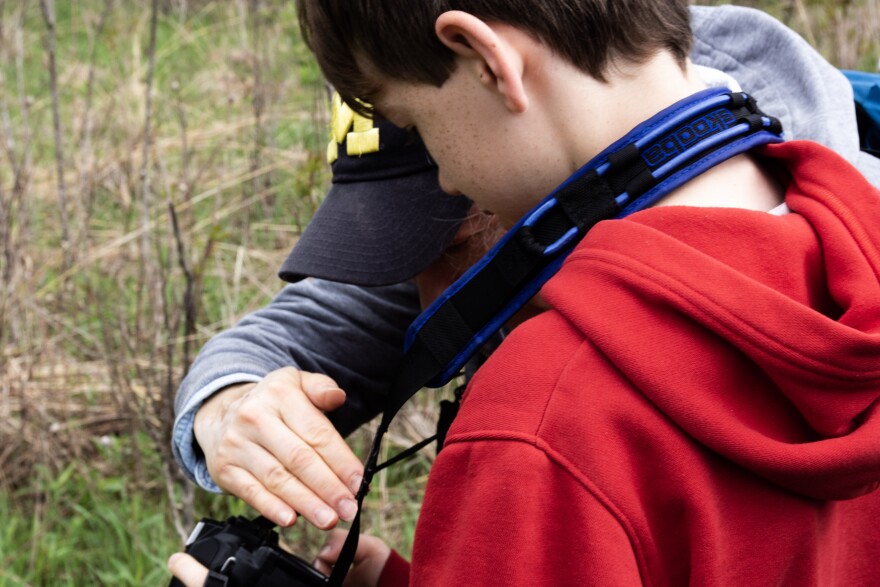Mornings in Michigan is our series about morning routines and rituals around our state. This time of year, some people get up early to see migrating birds arriving in Michigan. Mike Kielb and his wife sometimes get up at 4 a.m.
“We really enjoy the first songs of the day. People don’t like to get out when it’s dark, and dark is special. It’s a crossover. You get the birds that are active at night, the birds that are active during the day,” says Kielb.
Every Thursday morning during spring and fall migration, birders meet up at the Nichols Arboretum in Ann Arbor. We joined them for a walk.
We’re gathered in a culdesac at the edge of the arboretum.
Juliet Berger does a quick head count.
“So how many folks do we have here today? ‘A lot’… one two three… 20?” she says.
She’s president of the Washtenaw Audubon Society, and the ornithologist for the city of Ann Arbor.
The walk hasn’t officially started yet, but people are already finding birds in the neighborhood trees.
“Let’s get going, ‘cause it’s awesome!” says Berger.

As we spread out along the trail, everyone’s scanning the trees and bushes and ground for movement.
Suddenly, someone says, “stop!” and we all hold still.
Up go the binoculars.
“Palm warbler, low…. Nice!” says Berger. “Oh, something big flying over… it’s a Canada goose,” she laughs.
We only walk a few steps before we see the next bird.
“Oh, indigo bunting!” Berger says, with excitement. “In this skinny little tree, he’s the bluest bird at the top. That is the most beautiful bird.”
The indigo bunting zips between trees, a flash of bright blue. It’s what Juliet Berger calls a “spark bird.”

“Everyone has a spark bird. You see your first scarlet tanager and it’s 'ahhh, that’s what I’ve been missing all my life,' right? It’s so beautiful, the scarlet red with the black wings, it’s incredible. When a person sees a bird up close for the first time they’ve never seen before, their face lights up.”
She says it’s thrilling for her to see. Berger was a social worker, earlier in her life. She says she loves connecting people to each other, and now, with birds.
Learning mnemonics

Once you’re hooked on birding, there are all sorts of ways to tell the songs apart. Birders come up with phrases that sound like the songs.
Jim Law mimics a chestnut-sided warbler he sees in a tree above us.
“It’s been singing, this is the first time he showed itself. 'Pleased pleased pleased to meetcha,’” Law says with a laugh. “If you have these mnemonics or phonetics attached to a bird, it helps memorize them in the future.”
Berger imitates the indigo bunting’s song: “Sweet sweet chip chip bling bling ba-da-da-da-buh.”
A moment later, a Baltimore oriole sings for us.
“That’s the Baltimore oriole song,” says Berger. “My dad used to say cha cha cha beedo beedo boop.”
Berger says she grew up birding with her dad, Sam.
“It really connects me with my father. When the white-throated sparrow sings, ‘old sam peabody peabody peabody;’ my dad was Sam and that was his favorite bird, and he would whistle that song when we were out in the woods together and they would respond,” she says. “Sometimes a white-throated sparrow will jump into my yard and sing that and I’m connected right up with my dad.”
Eventually, we come to a big mushroom-shaped tree Juliet Berger calls the “magic warbler tree” where she’s sometimes seen 10 or 15 species of warblers. But right now, there are two orioles in it, a male and a female.
“Oh look, they’re interacting,” she says with a giggle. Then, another male flies in to join them.
“Okay! So the males are trying for that one female,” says Berger.
“It’s the same menage a trois we’ve been following all day,” Cathy Theisen says, and she and Berger laugh.
We follow the path and head down by the Huron River.
James Rooney steps into the woods to snap some photos of a rose-breasted grosbeak. He’s the youngest member of the group. He’s 12.
“I think in the morning, it’s just more calming because you know, you just woke up and you’re not in a rush to do anything or you’re not remembering stuff about tomorrow, you’re just focusing on the now and stuff,” he says.

There was a lot to focus on: the group saw 68 species in all. More than a dozen kinds of warblers, four kinds of vireos, a kingfisher … and four Canada geese.
You can join the spring migration bird walk (find out more info here) in the Nichols Arboretum tomorrow and next Thursday, May 31. Both walks start at 8am.
Lauren Talley contributed reporting to this story.











